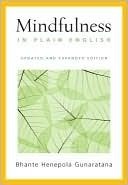More on this book
Community
Kindle Notes & Highlights
The habit patterns that presently control your mind will lock you into that suffering, and there will be no escape. A bit of time spent in learning alternatives to those habit patterns is time well invested.
Check your cushion, too. It should be about three inches in height when compressed.
You watch its ebb and flow and something surprising happens. It no longer hurts. Suffering is gone. Only the pain remains, an experience, nothing more. The “me” who was being hurt has gone. The result is freedom from pain.
Pain is a mental state. You can be mindful of pain just as you are mindful of breathing.
A few are completely convinced that they will get gangrene from lack of circulation.
It is best to eat lightly if you are about to meditate. Or wait an hour after a big meal.
Mental images are powerful entities.
Vipassana meditation is primarily an exercise in awareness. Emptying the mind is not as important as being mindful of what the mind is doing.
The emotional contents of a thought complex often leak through into your conscious awareness long before the thought itself surfaces.
bystander.
AGITATION
Restlessness
Missing a single practice session is scarcely important, but it very easily becomes a habit.
misbegotten
Take a good strong look at the emotional response you are trying to get rid of. Actually ponder it. See how it makes you feel. Look at what it is doing to your life, your happiness, your health, and your relationships.
Generosity cancels greed. Benevolence and compassion cancel hatred. You can find a specific antidote for any troubling thought if you just think about it awhile.
Fight with them and they gain strength. Watch them with detachment and they wither.
Trickiest of all, however, are those really positive mental states that come creeping into your meditation. Happiness, peace, inner contentment, sympathy, and compassion for all beings everywhere.
Your relation to sensation should never be one of past or future but always of the simple and immediate now.
The very fact that you have felt that wake-up sensation means that you have just improved your mindfulness power.
That means you win. Move back to the breathing without regret.
quagmire
Positive attachments hold you in the mud just as assuredly as negative attachments.
Mindfulness (Sati)
vipassana (insight)
When you first become aware of something, there is a fleeting instant of pure awareness just before you conceptualize the thing, before you identify it. That is a state of awareness.
That flowing, soft-focused moment of pure awareness is mindfulness.
It is the purpose of vipassana meditation to train us to prolong that moment of awareness.
If you are remembering your second-grade teacher, that is memory. When you then become aware that you are remembering your second-grade teacher, that is mindfulness. If you then conceptualize the process and say to yourself, “Oh, I am remembering,” that is thinking.
A serious meditator pays bare attention to occurrences all the time, day in, day out, whether formally sitting in meditation or not.
present. As soon as you are noticing that you have not been noticing, then by definition you are noticing and then you are back again to paying bare attention.
Fully developed mindfulness is a state of total nonattachment and utter absence of clinging to anything in the world.
Concentration is the lens. It produces the burning intensity necessary to see into the deeper reaches of the mind. Mindfulness selects the object that the lens will focus on and looks through the lens to see what is there.
Just as important, however, is the creation of a distraction-free emotional environment.
Mindfulness is cultivated by a gentle effort. You cultivate mindfulness by constantly reminding yourself in a gentle way to maintain your awareness of whatever is happening right now.
Mindfulness means seeing these facts and being patient with ourselves, accepting ourselves as we are.
acceptance is the essence of mindfulness.
A couple of months down the track and you will have developed concentration power.
Then you can start pumping your energy into mindfulness.
The more concentration power you have, the less chance there is of launching off on a long chain of analysis about the distraction.
This is not a race. You are not in competition with anybody, and there is no schedule.
Meditation that is not applied to daily living is sterile and limited.
One of the most memorable events in your meditation career is the moment when you first realize that you are meditating in the midst of a perfectly ordinary activity.
You realize that you could actually spend the rest of your days standing aside from the debilitating clamoring of your own obsessions, no longer frantically hounded by your own needs and greeds. You get a tiny taste of what it is like to just stand aside and watch it all flow past. It’s a magic moment.
We specifically cultivate awareness through the seated posture in a quiet place because that’s the easiest situation in which to do so.
alluring


